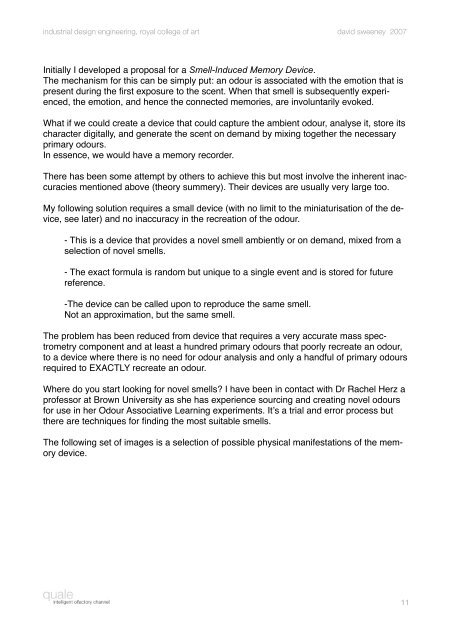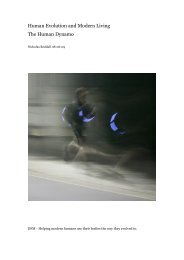industrial design engineering, royal college of art david sweeney ...
industrial design engineering, royal college of art david sweeney ...
industrial design engineering, royal college of art david sweeney ...
Create successful ePaper yourself
Turn your PDF publications into a flip-book with our unique Google optimized e-Paper software.
<strong>industrial</strong> <strong>design</strong> <strong>engineering</strong>, <strong>royal</strong> <strong>college</strong> <strong>of</strong> <strong>art</strong> <strong>david</strong> <strong>sweeney</strong> 2007<br />
Initially I developed a proposal for a Smell-Induced Memory Device.<br />
The mechanism for this can be simply put: an odour is associated with the emotion that is<br />
present during the first exposure to the scent. When that smell is subsequently experienced,<br />
the emotion, and hence the connected memories, are involuntarily evoked.<br />
What if we could create a device that could capture the ambient odour, analyse it, store its<br />
character digitally, and generate the scent on demand by mixing together the necessary<br />
primary odours.<br />
In essence, we would have a memory recorder.<br />
There has been some attempt by others to achieve this but most involve the inherent inaccuracies<br />
mentioned above (theory summery). Their devices are usually very large too.<br />
My following solution requires a small device (with no limit to the miniaturisation <strong>of</strong> the device,<br />
see later) and no inaccuracy in the recreation <strong>of</strong> the odour.<br />
- This is a device that provides a novel smell ambiently or on demand, mixed from a<br />
selection <strong>of</strong> novel smells.<br />
- The exact formula is random but unique to a single event and is stored for future<br />
reference.<br />
-The device can be called upon to reproduce the same smell.<br />
Not an approximation, but the same smell.<br />
The problem has been reduced from device that requires a very accurate mass spectrometry<br />
component and at least a hundred primary odours that poorly recreate an odour,<br />
to a device where there is no need for odour analysis and only a handful <strong>of</strong> primary odours<br />
required to EXACTLY recreate an odour.<br />
Where do you st<strong>art</strong> looking for novel smells? I have been in contact with Dr Rachel Herz a<br />
pr<strong>of</strong>essor at Brown University as she has experience sourcing and creating novel odours<br />
for use in her Odour Associative Learning experiments. It’s a trial and error process but<br />
there are techniques for finding the most suitable smells.<br />
The following set <strong>of</strong> images is a selection <strong>of</strong> possible physical manifestations <strong>of</strong> the memory<br />
device.<br />
11



